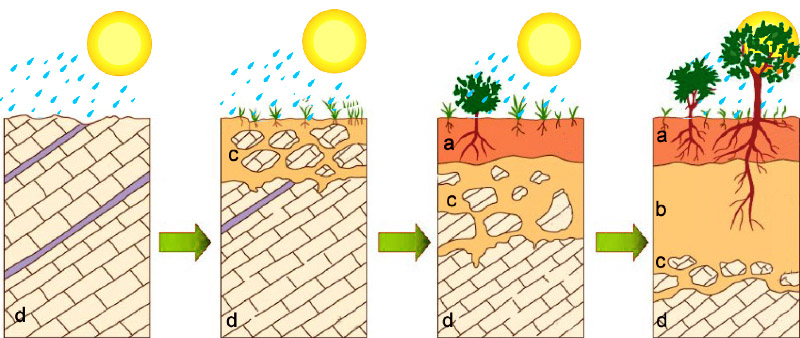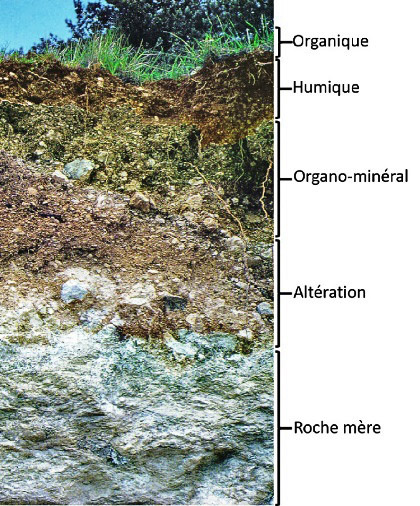Soil formation:
It seemed to me useful to write an article to briefly discuss how soils evolve from the stage of the source rock. This process is the same since the origins of the Earth. Without him, life might not exist in the forms we know today. The sketch below1 summarizes the formation of soils in four stages:

(a): Humic zone. (b): Organo-mineral zone. (c): Alteration zone. (d): Mother Rock.
Step 1: The mother rock * that outcrops is subjected to climatic actions. Rain, winds, runoff, frost, exposure to the Sun but also action of so-called pioneering plants that develop a whole arsenal of strategies to conquer new territories. The roots of these last ones try to interfere in the smallest cracks or interstices that they meet and, thus, participate in the fractionation of the rocks. The action of water is also responsible for a phenomenon called leaching in which the soluble chemical elements are buried deeper. It is at this stage that clay, calcite and quartz separate. In turn, these are altered by the infiltration of rainwater. Their chemical transformation or their recombination (micas argilisation, iron release and oxidation ...) contribute to new minerals that in turn enrich the soil.
Step 2: The first plants are renewed and die leaving organic compounds while the mineral fragmentation is prolonged. At this stage a fine litter is already present which becomes a natural habitat to allow the establishment initially of a microflora (fungi and bacteria) followed by a microfauna (nematodes, mites and springtails) then a macro fauna (earthworms and insects).
Step 3: Once in place, the actors of the organic decomposition of soils contribute to the formation of humic layers where the organic and mineral components are closely intertwined. These layers becoming thicker, a new form of vegetation will be able to take root. It is at this stage that leafy vegetation appears which will accelerate the production of organic masses by scattering their foliage on the ground.
Step 4: During all these cycles the activities described in each of the previous steps continue simultaneously contributing to a potentiation of all the processes that will ultimately result in a fertile and deep soil.
Note: All these steps take place over very long periods of time that are relatively slow on our time scale. Starting from the parent rock, we consider an order of magnitude of 1000 years to constitute the first 10 centimeters of a soil.
* The mother rock is not homogeneous on Earth, it can be of different natures: Metamorphic (hard): granite, shales, sandstone. Sedimentary (soft): chalk, marl, clay or furniture like sand and scree.
Soil strata:
 Soils can be considered as a living system resulting from the long-term action of different mechanical, chemical, plant and animal interactions. Opposite one can see concretely the various horizons * constituting a soil:
Soils can be considered as a living system resulting from the long-term action of different mechanical, chemical, plant and animal interactions. Opposite one can see concretely the various horizons * constituting a soil:
The upper layer of the organic horizon is composed of plant debris (leaves, grasses, dead plants and wood) and residues of animal origin (droppings and corpses ...)
The humic horizon is derived from the degradation of organic matter under the action of bacterial, fungal and animal decomposers. (see article on organic decomposition). Mixed with clay under the action including worms and insects.
The organo-mineral level is a stratum in which mineral and organic materials are mixed rather roughly. This zone contains mineral and chemical elements (clay, iron, organic matter, calcium carbonate, salts, etc.) and chemical and organic elements.
The weathering horizon characterizes the first stage of the transformation that the rock will undergo. The mineral material leaves very little room for organic matter. It is at this level that the two modes of physical and chemical transformation intervene. The disintegration of the parent rock separates the constituent minerals of the latter. For example if the bedrock is granitic, quartz, feldspar and mica will be dissociated and then chemically altered (mainly by hydrolysis in contact with infiltration water and by oxidation) to give so-called secondary minerals.
* Each identifiable and distinct layer of a soil is named "horizon".
1: Adapted from a sketch from "Le sol union of organic and mineral matter" - Patrick.Hautefeuille - agronomist - 2017.